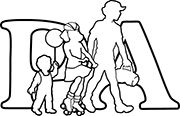Remembering the facts about car safety can be mesmerizing; however, keeping your child safe while riding in the car is one of the first and most important jobs that parents have!
Here are some of the basics:
Infants and toddlers should ride rear facing until they are two years old. This seat can be a rear facing only bucket seat or a convertible seat that can later change to be forward facing. Many people ask what to do if their child’s legs touch the back of the car before they are two. Crash tests support rear facing car seats as the safest until two years old, with leg injuries being very rare.
After 2 years old, toddlers should ride in a forward-facing car seat with a harness for as long as possible – until they reach the height and weight limits of the seat, or at a minimum until 4 years old.
Once a child meets the height and weight limits for the seat, s/he should use a booster seat until the child is 4 feet 9 inches (about age 8-12 years old), or the seat belt in your vehicle fits appropriately across the shoulder and chest (off of the neck). An adult seatbelt fits properly if the lap belt fits snugly across the upper thighs not the belly and the shoulder strap lies across the mid chest and shoulder, no the neck or throat.
The middle of the backseat is usually the safest place to install your car seat; however, in some cars it is difficult to make the seats fit tightly, in which case the side is safer. Most new convertible car seats and new cars have the ability to use the LATCH system for extra security and this system should be used whenever possible. If you aren’t sure how or where to install the car seat in your vehicle, many fire stations have trained personnel to install the seat or check your installation job. To check for car seat inspectors near you, check http://www.nhtsa.gov/apps/cps/index.htm
Don’t forget that the safest place for all children younger than 13 years old is the backseat.
Finally, check the dates on car seats – they can expire. Also, if the seat has been in a moderate or severe crash, the seat should no longer be used as safety cannot be guaranteed. Therefore it is recommended that any car seat that you use be new and not used. Those who qualify for Medicaid or FAMIS are eligible for a free car seat through WIC after attending a short class. More information is available at http://www.vdh.virginia.gov/thomas-jefferson/community-health-programs/. If you have any questions about your car seat, your pediatrician is a great place to start!
Of course, don’t forget to model safety for your older children — buckle up every time you get in the car!
Paige Perriello, MD, FAAP
Pediatric Associates of Charlottesville

